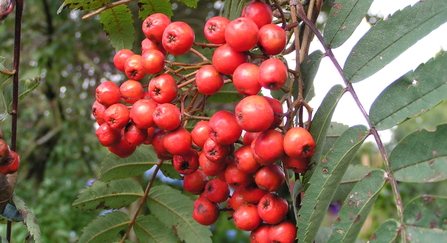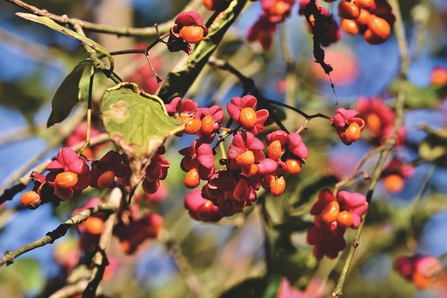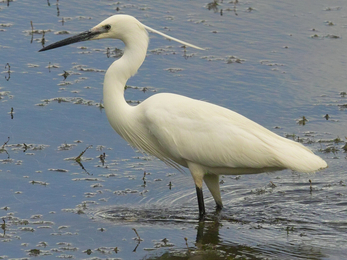
Fly Agaric {Amanita muscaria} (c) Ross Hoddinott/2020VISION
Shropshire in Autumn
SEPTEMBER, OCTOBER AND NOVEMBER
Who doesn't look forward to that first proper autumn morning – the air changes, smells get sharper, mist rises off the meadows and, even though the leaves are still green, you sense that everything is changing. The light is somehow altered, and soon there will be frost, falling leaves crisp beneath our feet, and the scent of wood fires in the evenings.
Nature, too, is getting ready for winter. Most obvious are the deciduous trees. Leaves will start to change colour as their green chlorophyll breaks down, and fall in a glorious riot of tawny reds and yellows, picked out by the golden light filtered through the opening canopy.

Japanese Maple (c) Gillian Day
Truly red leaves are uncommon in native species, but exotic species such as maples add a splash of vermillion to the natural palette.
Explore autumn woodlands at Earl’s Hill, The Ercall or Clunton Coppice. The colour will be best after a frost, when you can indulge yourself by wrapping up warm in your favourite scarf and mittens, kicking through drifts of crunchy leaves and looking forward to a well-deserved mug of cocoa when you get home.
While you’re in the woods, look out for some of our spectacular fungi. Bright splashes of red, yellow, purple and russet show the fruiting bodies of these complex organisms, which may stretch for huge distances in underground webs of mycorrhiza, intricately associated with the tree roots.
Look for the iconic red and white fly agaric in birch woodland, bright purple amethyst deceiver and translucent white porcelain fungi in mixed deciduous woodland, delicately apricot-scented yellow chanterelles and stunningly rude-looking, offensive-smelling stinkhorns. The variety is really astounding!
Unimproved grasslands too can be great hunting grounds for fungi, particularly the brightly coloured wax-caps – stunning red, yellow, green, pink or white little jewels in the grass. Melverley Meadows reserve near Whitchurch is particularly good for wax-caps, and close to Brown Moss, where a good variety of woodland species can be seen if you fancy a mycological day out. Dudmaston estate, a National Trust property near Bridgnorth is another good site for fungi.
Autumn also offers some wildlife spectacles of an altogether livelier kind.

Red deer (c) Jon Hawkins - Surrey Hills Photography
Experience the testosterone-fuelled frenzy of the red deer rut as the mating season gets under way for these impressive beasts. They’re not a wild species in Shropshire, but you can see them, hear them and smell them too at Attingham Park as the impressively antlered stags battle for supremacy and control of a harem of hinds. Fallow deer are also resident in the park, displaying splendid palmate antlers grown specially for this season.
Wild salmon are also on the move, heading up their natal rivers to spawn in the shallow headwaters.

Leaping salmon (c) Rob Jordan/2020VISION
The males are particularly spectacular in their courting colours – silver bars of muscle flushed red on the underside, and displaying a fine hooked jaw or kype. Shrewsbury weir allows you to see them in their full glory as they leap to pass the obstacle, heading upstream to spawn in Wales, or you could try Ashford Carbonell weir near Ludlow, which the fish pass to breed in the upper reaches of the River Onny.
Autumn is a great time to look out for unusual birds. Several places in Shropshire are known to attract passage migrants – birds not normally seen here but which are moving between their breeding grounds in the north and southerly wintering quarters.

Dunlin (Calidris alpina) (c) Chris Gomersall/2020VISION
Wood Lane reserve can attract interesting waders such as ruff, black tailed godwit, green and pectoral sandpiper, greenshank and dunlin. Terns can be seen here, stopping off on their long-distance migration, and autumn often finds great white and little egrets around the North Shropshire meres. Watch out for the first of the winter wildfowl too, as many arrive to overwinter in Shropshire.
Hopefully, our trees and hedges will be laden with fruit – a berry bonanza for foragers and wildlife alike. Even if you don’t fancy picking some, be inspired by the sheer glory of the laden bushes.

Rowan berries (c) Richard Burkmar
Dusky haws, bright scarlet rose hips, golden crab apples and vivid rowan berries dripping from the trees all advertise themselves as a sugar-rich treat to help mammals and birds fatten up for the cold season ahead, and get their seeds dispersed at the same time.
The mouth-puckeringly sharp purple sloes ripen a little later, just in time to make some sloe gin for Christmas and watch the thrushes defending their chosen larder of fruit.

Spindle
Take a basket and make the most of the hedgerow harvest, indulging in a little wildlife-watching at the same time! If you’re not looking for something edible but just want to feast your eyes, hunt down a spindle tree.
These small trees have the most spectacular candy pink fruits which split to display brilliant orange seeds. Find them in limestone areas such as Wenlock Edge or the Oswestry hills for a psychedelic ‘sixties’ arboreal hit
A little spider-watching is always a fine way to waste some time, and autumn is the season to appreciate those fat-bodied garden spiders weaving their beautiful symmetrical webs. Picked out by frost or bejewelled with mist droplets, the webs become visible to us – they were there all along, but we just didn’t notice them.
Take time to appreciate the mastery of the thing. Each orb web we think of as a ‘typical’ spider web takes around two hours to build, and is made of strands which are highly flexible, extremely stretchy, stronger than steel and, when formed into a mesh, can stop a bullet. Nature really is marvellous – all that just to catch your dinner. Look in parks and gardens, as well as country hedges, and be amazed.

Garden orb spider (c) Vaughn Matthews
While you’re in the garden, look out for late butterflies. Peacocks and red admirals enjoy the sugars in fallen apples, becoming rather intoxicated by the fermenting fruit. You might have to help them home!

Red admiral
So do get out and relish the glories of autumn around the county, a special trip to see something new or just noticing something new close to home. Every season has its own particular beauties, and the turning year offers a different picture with each passing week.
Autumn Blogs

Birds on the move
For many birdwatchers, autumn is the most exciting time of year. But what are they so excited about?

Dr Cath's Nature Notes - November 2023
This month I’m rambling along the hedgerows. The pastoral landscape of England is defined by hedges – something rarely seen in the rest…

Dr Cath's Nature Notes - October 2023
Birch trees are among the first to start showing their autumn colours – tinged with yellow even in September, and soon to be dropping a…

Dr Cath's Nature Notes - September 2023
There’s a great feeling of anticipation in birdwatching at this time of year. Passage migrants, by their very nature, are unpredictable…

The importance of Autumn berries and seeds
Say “autumn” to someone with an interest in the natural world and there’s a good chance that person will immediately think of shortening…

Dr Cath’s Nature Notes – October
October is, for me, the beginning of autumn proper. Colder nights, dewy dawns and the chance of frost. I love it!










